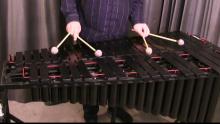Strange Meadow Lark
So last summer I posted a lesson entitled "Incorporating Brubeck Ideas into your Solo Vibe Practice and Performance" where I discussed different solo vibraphone techniques I learned from practicing a reduction of Dave Brubeck's performance of Strange Meadow Lark. For those interested in the article the link is below:
https://www.vibesworkshop.com/blog-entry/incorporating-brubeck-ideas-yo…
- Read more about Strange Meadow Lark
- 1 comment
- Log in or register to post comments
Practice Comping Using Set Rhythms Pt. 2 by Behn Gillece
Mic Wars, Episode III Shure SM57 vs. Rode NT1A
OK.. this may be getting silly. You know the drill if you checked out the first two. MP3 file is AABA starting with one mic, then switching to the other with each section. It is my hope that you can hear which is which because, this time, I have placed two VERY VERY different mics against each other.
- Read more about Mic Wars, Episode III Shure SM57 vs. Rode NT1A
- Log in or register to post comments
Scales for Chords
Putting the Scales in the Chords
This is an old lesson, but I think it's good. The audio is down at the bottom of the text.
So think of the scales this way. The chord tones and the notes between the chord tones are the scales. For example:

- Read more about Scales for Chords
- Log in or register to post comments
Mic Wars, Episode II Neumann KM184 vs Chameleon Labs TS-1
So, in the first episode, I used two mics I considered substantially different. Tony and I discussed it a bit and we agree... as different as they are, there are a lot more similarities than differences and the differences are not in quality but rather character. Of course, assisting the musicians have exactly the correct character to their sound is what defines great recording engineers like the late Rudy Van Gelder.
Mic wars - Earthworks SR25 vs AKG 414B
SO, I think this may be more of what Tony was looking for here... I chose the AKG 414B as a comparison because it is a mic I get put on me a lot in studios that don't really record vibes a lot. It's a great mic, but you can decide if you prefer it. I will do some more comparisons in later posts to other mics.
- Read more about Mic wars - Earthworks SR25 vs AKG 414B
- 5 comments
- Log in or register to post comments
Practice Comping Using Set Rhythms by Behn Gillece
TOTM - Minority - My Practice Version
I work hard on our TOTM's. VW for me is a chance to teach and learn :-)
Sorry about the pedal noise! Something was loose. And this of course was the best version! First take! The others I didn't like however they make NO noise!
- Read more about TOTM - Minority - My Practice Version
- Log in or register to post comments
TOTM - Minority - Simple Exercise Over the Changes
Chinese translation for Chinese students
這邊教大家一個簡單的小練習。
幫助你了解整首曲子、也幫助你了解更多和聲。
每個和弦都演奏一小段音階(從根音開始),
像這樣:
Fminor7: F,G,Ab,Bb,C
C7altered: C,Db,Eb,E,G
依此類推,用這個方式演奏整首曲子
- Read more about TOTM - Minority - Simple Exercise Over the Changes
- Log in or register to post comments



